AI is everywhere right now, on every roadmap, investor deck, podcast, and feature release. Product teams are shipping “AI-powered” features faster than merchants can evaluate them.
But if you work in fashion eCommerce, the question isn’t whether AI is trending. It’s whether it’s useful.
At Tagalys, we’ve been obsessing over how AI fits into product discovery and merchandising. But we’re cautious about this - we don’t want to build for the sake of it. We want to understand what helps brands sell better and move faster.
To find answers, we brought together two leaders for a panel discussion -
- Cal Wilson, Cofounder and CEO of The Working Party — one of Australia’s top Shopify Plus agencies. He’s worked with brands like Kukai, Assembly Label, and BlackMilk.
- Jackie Kruger, CEO of BlackMilk Clothing, a cult-favorite fashion brand known for its bold identity. With over 20 years of experience in fashion, retail, and tech, Jackie was named one of Inside Retail’s Top 50 People in eCommerce in 2024.
Moderated by our CEO, Tony Kattukaran, this panel took place live at ICC Sydney as part of Online Retailer 2025.
We spoke openly about what’s working with AI in fashion eCommerce today, what’s not, and where AI can help fashion teams in the future. From visual search and conversational commerce to reporting and AI content, we explored the real opportunities, limitations, and next steps that can improve the customer journey.
This blog includes insights from our panel discussion. So, if you’re trying to figure out how AI fits into your roadmap, I hope it gives you something valuable to take back to your team.
Here’s what we learned.
Full panel discussion: “AI in Fashion eCommerce: Hype, Hope, or Here to Stay”
AI-assisted search has untapped potential
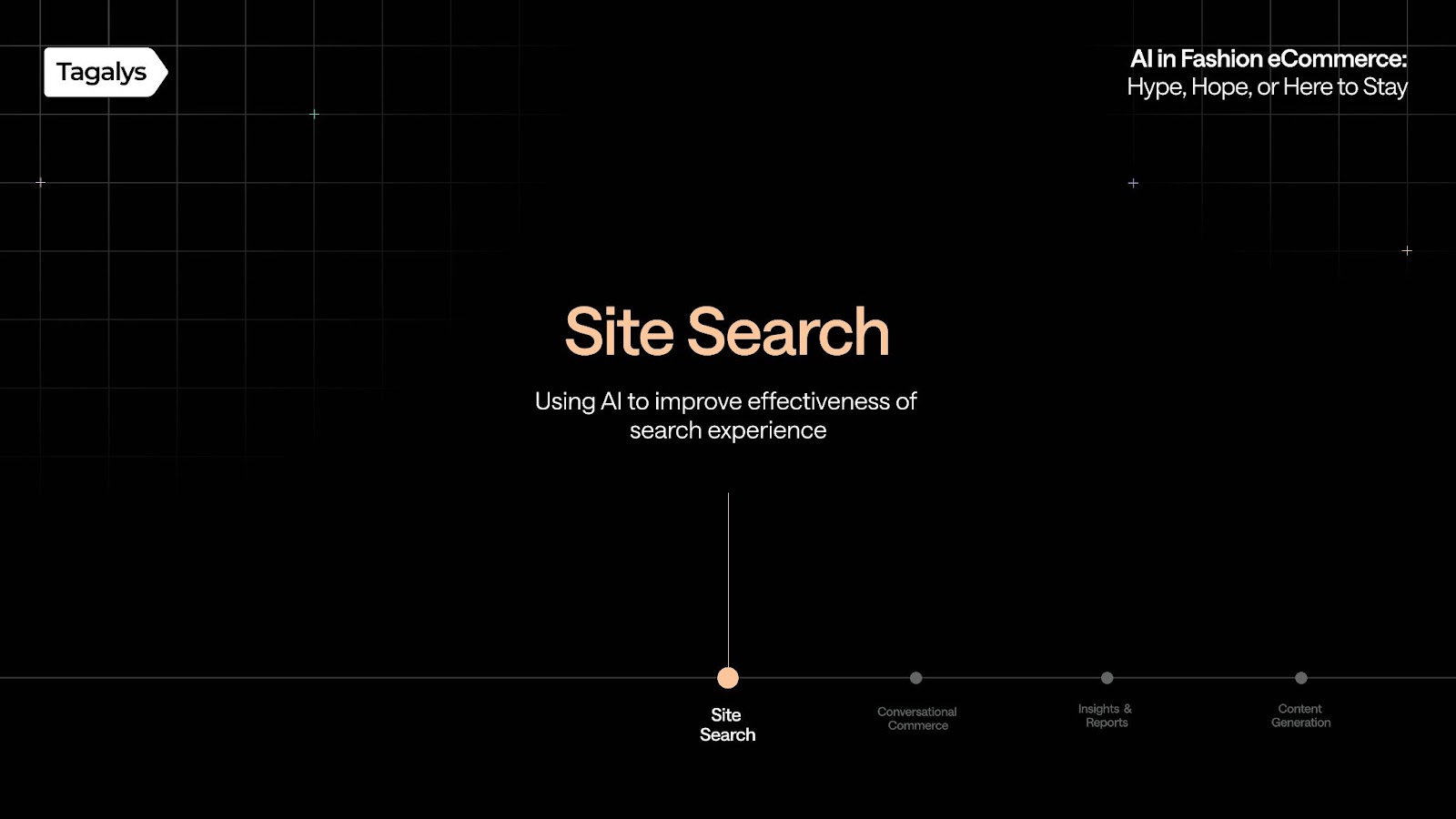
We kicked off with site search, consistently one of the highest-converting channels in fashion eCommerce, yet one of the most under-optimized. Jackie set the stage clearly:
Visitors who use site search typically have higher purchase intent. If you can serve them relevant content, whether through keyword searches or image results, you’ll convert them faster.
At Tagalys, we see two recurring issues with search in fashion storefronts:
Problem 1: Search dashboard management is still too manual
Tuning search relevance, configuring synonyms, and fixing inaccurate search results still takes a lot of effort and time. And when it’s done wrong, it costs you conversions.
Jackie shared an example of a brand that switched from keyword-based to image-based results without proper testing. Their conversion rate tanked immediately.
Cal sees the same issue:
We spend so much time manually improving search results. But AI can handle that 24/7 and just report back on performance. Additionally, it can even identify what to A/B test.
Automating search tasks using machine learning and AI frees up time for teams to focus on strategy and creativity, along with boosting sales. However, while AI can optimize search results and accelerate product discovery, it still requires careful validation.
Problem 2: Shoppers want to use natural language, and most search engines can’t handle it
Visitors are starting to search like they talk. Phrases like “I need a dress for my sister’s wedding on the Gold Coast” don’t fit neatly into traditional search engines. They are getting more descriptive and natural.
These kinds of queries are rich in context, but most search tools can’t parse them effectively. Jackie pointed out that this behavior appears more frequently in live chat, rather than search bars.
Cal highlighted a broader shift:
There’s a UX gap between floating buttons, search bars, and chat. Unifying that experience is key.
Search and chat are converging. AI can bridge that gap if we build for it. A customer could use natural language in either interface. There is a significant opportunity to unify that experience. It doesn’t make sense to deliver the same outcome in two different ways using two different systems.
How to measure value?
Operational efficiency. When AI takes over repetitive dashboard tasks, like managing synonyms or tuning relevance, it frees up the team to focus on more strategic or creative work. That time saved is a real ROI.
What’s the verdict on AI-assisted search?
For most brands, fixing the basics, such as dashboard management, remains the more immediate priority. But the groundwork for handling natural language is being laid today.
The consensus here is that it’s evolving, but it’s no longer just hype. The tools exist, the use cases are real, and platforms like Shopify are already investing heavily in this space.
Conversational commerce is real, but still taking shape
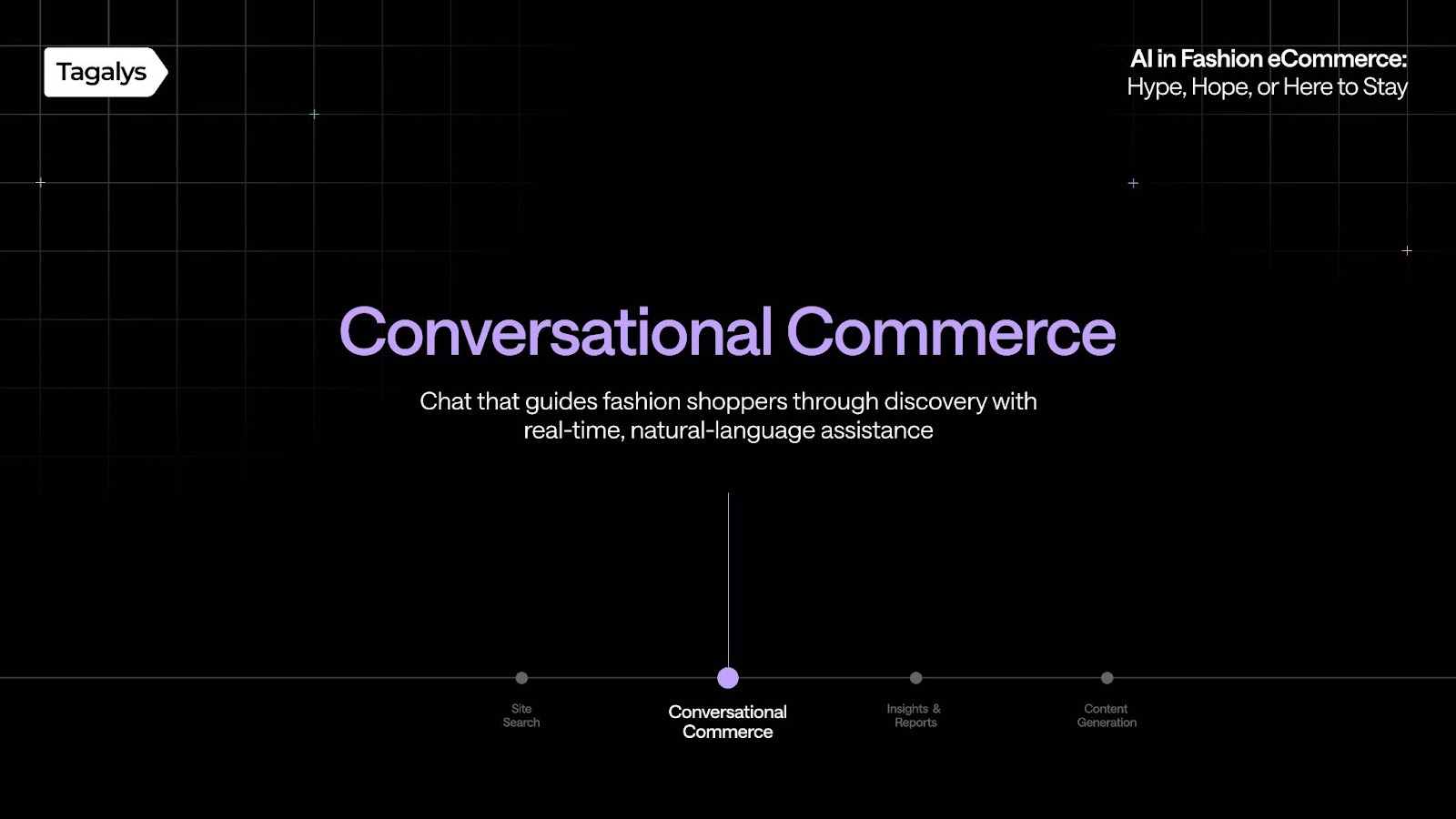
From site search, we shifted to another emerging theme: conversational commerce. This isn’t about ChatGPT or customer support. It’s about letting shoppers discover products by having a conversation, just like they would with a store assistant.
For many fashion brands, that idea still feels new. Most shoppers either tap the search bar or browse collections. But as behavior shifts and tools evolve, those lines are starting to blur.
Cal explained the retail roots behind the concept:
In fashion retail, we usually ask three questions to understand who the customer is, what they’re shopping for, and how to guide their decision. That’s what conversational commerce tries to replicate.
That framing helps. Because at its core, conversational commerce is about shortening the distance between customer intent and product discovery, especially in high-SKU environments where navigation can feel overwhelming and disrupt the shopping experience.
Can chat deliver a brand-first experience?
Discovery in fashion isn’t just functional. It’s visual. It’s emotional. It’s brand-first.
At BlackMilk, Jackie explained that while the technology is advancing rapidly, the experience must still align with what their brand stands for.
Our customer base prefers talking to a real person (over a shopping assistant). Our brand is built on authenticity, community, and connection.
They’ve already launched their bot, the BM bot, and are actively training it to reflect their tone, values, and personality. But for Jackie, trust and tone come first. Discovery has to feel like an extension of the brand, not a tech add-on.
Where is the opportunity?
Where conversational commerce shines is in global scenarios. If a customer wants styling advice or has a product question at 2 AM in another time zone, a trained AI assistant (trained on brand data and product knowledge) could be the difference between engagement and bounce.
While the potential is real, Cal pointed out, we’re not quite there yet.
There’s a UX gap between floating buttons, search boxes, and chat. Unifying that experience is key.
We asked Cal how product teams like ours could approach this problem - standalone solutions or plug into a Conversational AI platform?
Open up your data silos. Let other platforms build with it. That’s what creates better experiences.
And we agree.
What’s the verdict on AI for conversational commerce?
For brands wondering if conversational commerce is worth it, Cal had a pragmatic answer:
Every fashion brand should at least consider tools that improve experience and the bottom line.
There’s still hesitation in the market, but it feels like a matter of time. As expectations shift and tools mature, the idea of “just asking” your way to a product might become the new normal. That said, it is not for all fashion brands.
Reporting is where AI delivers real value right now

Of all the AI use cases we discussed, reporting and insights felt the most mature. While other areas still feel early, this is where AI is already proving its value by saving time, surfacing trends, and helping teams act faster.
Jackie was quick to name Shopify Sidekick as a game changer.:
Especially running ShopifyQL queries and analyzing performance across different regions, identifying what’s working, what’s not, and prepping our Monday trade reports. Even the recommendations it’s starting to provide are getting better over time.
That kind of automation is especially useful for a brand like BlackMilk, where sales don’t follow a typical weekly pattern. Instead of relying on cookie-cutter reports, Sidekick lets her compare across specific drops and find meaningful insights. And importantly, it’s not a black box.
I can click into the queries, view the raw data, and validate it. That transparency builds trust.
Cal echoed a similar experience with an AI analytics tool he uses to bring together and analyze performance data for fashion retailers.
It helps me build the reports I already know I want, but it also surfaces insights I didn’t even think to look for. It sees things I’ve missed. That’s the magic.
It also identifies emerging fashion trends, helping brands adapt more quickly to what’s resonating with customers.
This is where AI’s value becomes crystal clear, not just in showing you what’s already happening, but in helping you discover what you didn’t know to ask. It gives fashion retailers access to fast, actionable customer insights that can reshape collections and marketing in real time.
The key to value: prompt literacy and decision-making
But both Cal and Jackie emphasized that these tools are only as good as the questions you ask them.
Prompting is critical. You need to learn how to talk to the tool to get what you want. But once you do, it becomes a superpower.
That’s where AI moves beyond traditional reporting and and becomes a digital transformation enabler and a thinking partner, helping teams ask smarter questions, validate gut feel, and act faster.
However, the real power kicks in when insights are turned into action. Whether that means launching a promotion, re-sorting a collection, or flagging a slow-seller, AI that closes the loop from insight to decision is what teams need most.
What’s the verdict on AI-assisted reporting?
When we asked whether this is a passing trend or something lasting, Cal didn’t hesitate.
Who wouldn’t want a 10x assistant you can ask anything, 24/7? It’s life-changing.
AI-generated content still feels risky, for now.
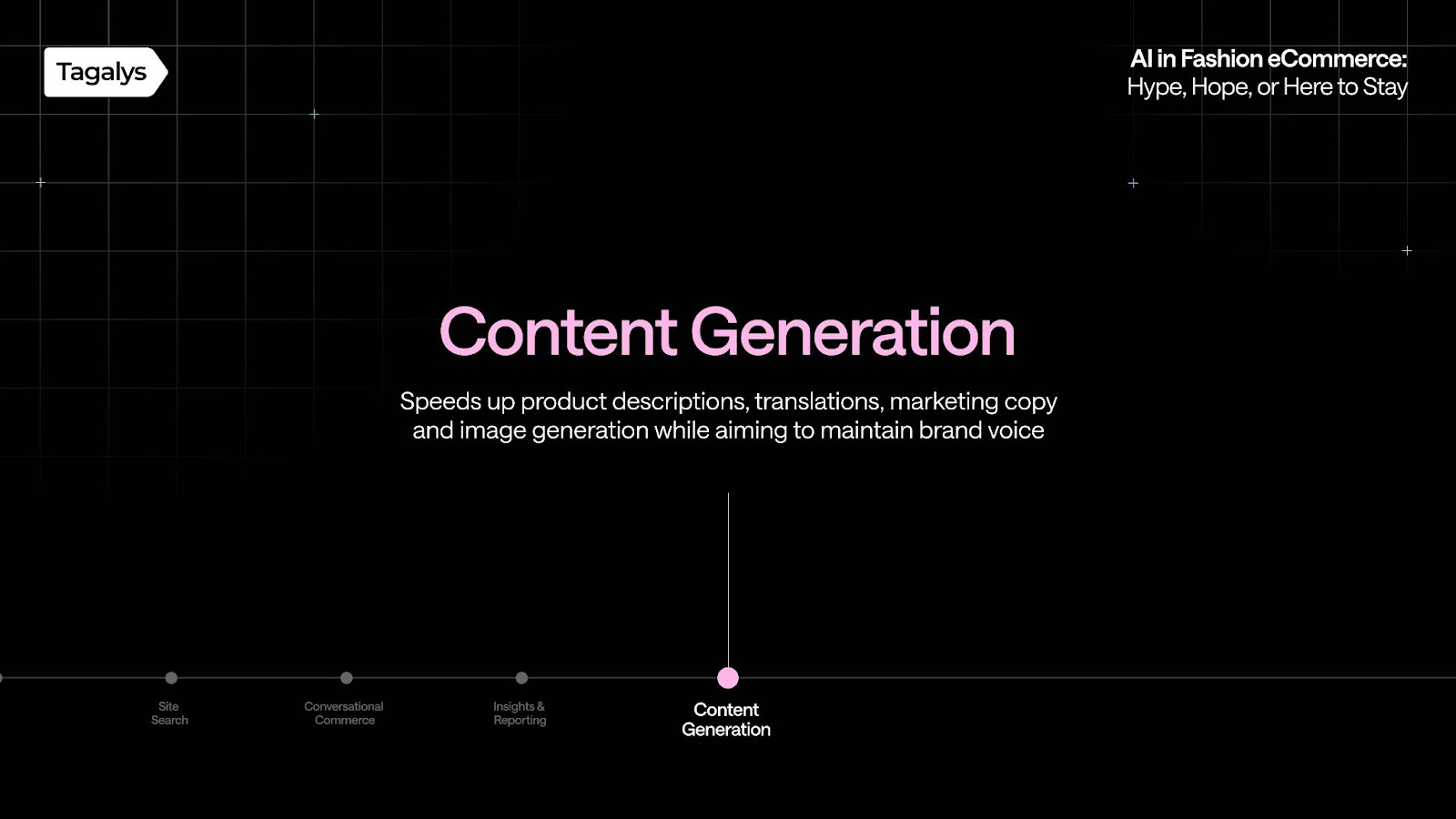
Of all the AI use cases in fashion, content generation is probably the loudest. From product descriptions to SEO copy and social posts, it’s easier than ever to spin up text. But for fashion brands, content isn’t just about filling a page. It’s about tone, voice, and trust.
At BlackMilk, AI is already in use for copywriting, but always with brand voice in mind.
Yes, we use AI tools for copywriting. And to your point, it’s really important that what we put out still sounds like us.
Content is an extension of any fashion brand. That means getting AI to write isn’t enough; it has to feel like BlackMilk. And that takes effort.
Our customers don’t want to look like everyone else, so why would we want to sound like everyone else?
Getting AI to write in a brand’s voice doesn’t happen automatically. It takes deliberate input, feeding the system examples, guidelines, and nuance that usually lives in people’s heads. Cal described it as turning instinct into instruction.
We have to feed the model the right material so that it can sound like us. That means turning our intuition, what we just ‘know’ from being in the environment, into prompts and structured information the AI can use.
Some teams are even exploring AI-generated imagery to cut down on expensive photoshoots. But there’s still hesitation. There’s still an uncanny valley, a point where the generative AI in fashion doesn’t quite feel right.
That discomfort matters as fashion is a high-trust category. Especially online, where visuals have to do the heavy lifting. If the image doesn’t feel real, the product doesn’t either.
What’s the verdict on AI-assisted content creation?
While AI can support content creation, particularly in terms of speed and scale, it still requires human oversight. In fashion, trust and tone are too important to be completely automated. For now, AI is a helpful assistant and not a replacement.
What matters most in the next 12 months?
We ended with this question: Of everything we discussed, what will have the most impact this year?
Both Jackie and Cal pointed to the same thing: Reporting and insights.
“It’s where the time savings are real. And where strategy gets clearer” - Jackie
As AI tools mature, the ability to turn insights into action across the customer journey will define who leads in online retail and fashion discovery.
AI in Fashion eCommerce - where do we go from here
AI in fashion eCommerce has moved beyond the hype. The tools are here. Some of them are useful. Others are still maturing. But the value is becoming clearer, especially in search and reporting.
This panel helped us ground that. We heard from leaders working inside fast-moving retail teams. They shared where AI is delivering real ROI today, where it’s falling short, and what it takes to make it useful for fashion brands.
Some themes came up again and again. Manual search dashboards, repetitive merchandising, reporting that takes too long, or isn’t actionable.
These are the challenges that fashion teams face daily. And they’re precisely the kinds of problems we focus on solving at Tagalys. Solving them means better experiences for shoppers and stronger support for your customer service team.
For us, hosting this session was an opportunity to listen, learn, and reconnect with the problems that matter. We’ve learnt that AI doesn’t need to be flashy. It needs to reduce effort. Help teams move faster. Make the work feel lighter.
We are walking away from this conversation more focused than ever on building tools that do exactly that. Because in the end, AI-powered shopping isn’t the headline. The customer experience is.
If you’re a fashion brand on Shopify and figuring out how AI fits into your workflows, we’d love to learn more about it.
Talk to us as we build in this space.
Book a demo to see what we’re working on at Tagalys.


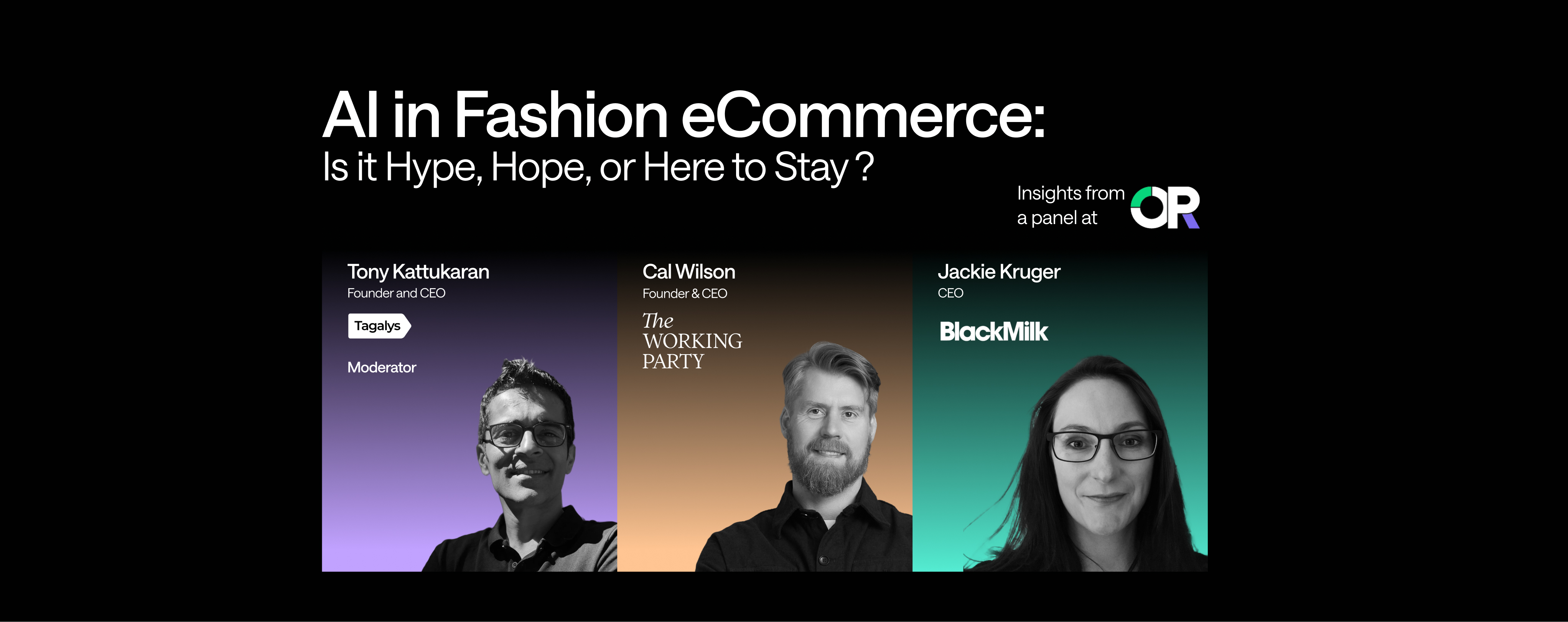

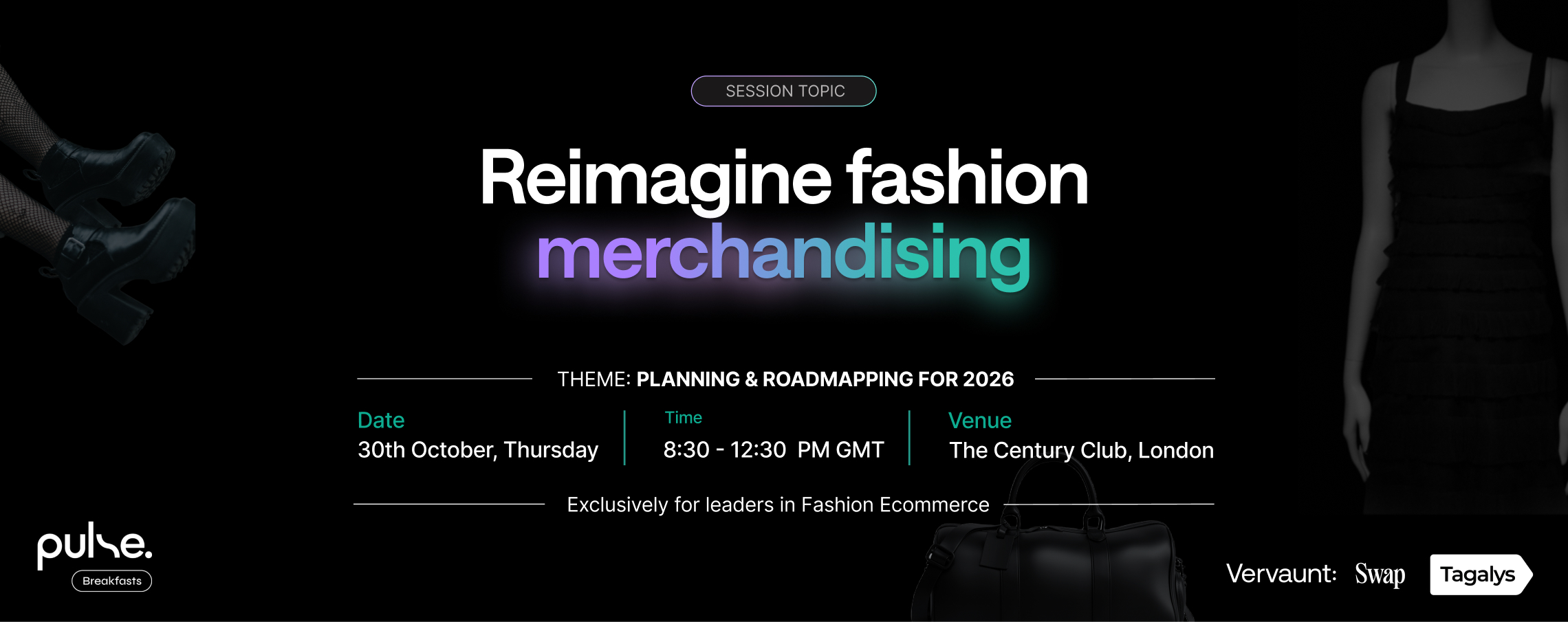








.svg)
.svg)
.svg)
.svg)
.svg)
.svg)



.png)

.png)
